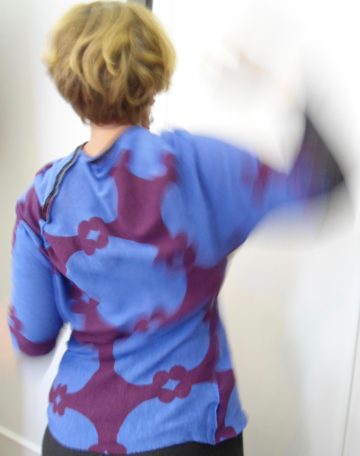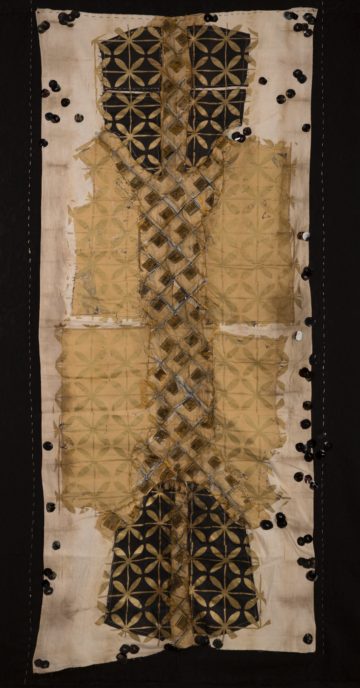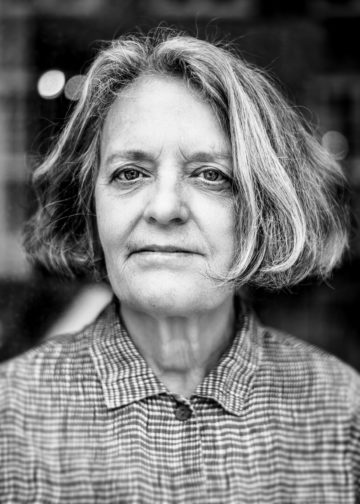
Who are you? My name is Dorothy Wedderburn. British and, since last year, proudly Dutch.
Where are you from/where were you born? I was born in northern Nigeria. Where I actually come from is more difficult to answer – my life has been quite nomadic, I grew up between Nigeria and England, then stayed put for a number of years in London before living abroad in various other countries. Since 1991 I have lived in the Netherlands. I think you could just say I’m a citizen of the world.
What do you make, and how do you make it? For Zône I make mainly wearable art such as jackets and tops. But I also make art pieces, which I call ‘hangings’, for on the wall. Everything I make is unique and individual. My materials are old garments and fabrics which I find in second hand shops and brocant markets, or which are given to me. These I combine with new sustainable cloth such as bamboo, ecological cotton, tencel, and the ends-of-rolls which would otherwise be sent to the dump. Inherent in all cloth is the sense of a story, of how/who/where it was produced, and when I take a pre-worn garment apart I almost feel like an archeologist, I can really sense its history. Before making a new jacket, for example, I let the old one sit for a while on the tailor’s dummy, somehow speaking to me and letting me know what I have to do. When I actually start creating I always have an idea of the end piece, but I allow the actual process to lead me along…cutting, stitching, dyeing and screen-printing. At each stage something unexpected might happen which can lead me in another direction. That is the part I really love. Somehow you are having a conversation with your work.

How did you end up on this path? I have always been drawn to cloth,which I love for its tactile qualities. My mother made most of her own clothes as well as mine, and when I was 5 an aunt gave me a miniature sewing machine. It actually worked and I copied my mother and made clothes for my dolls. I think my path was pre-destined.
At school we were taught the basics of ‘proper’ dressmaking. And there I also had an inspiring art teacher who introduced me to silk-screen printing, and used to take me shopping to buy suitable fabric to print on. She told me about art colleges and helped me to get a portfolio together. So I went on to study Fashion and Textiles at Ravensbourne College of Art and Design, in London. At that time it had just moved to new premises and was wonderfully equipped with a long print-table, a dye room, steamer, heat rollers, etc…. plus a really good technician.

Inspiration comes from everywhere. Art, architecture, what people wear, but also from more ephemeral things such as shadows and reflections. And of course nature is never-endingly inspiring in its patterns, colours and textures.
Do you do any other paid or unpaid work? I have been lucky in that my whole life I have worked with textiles: in small scale printing companies, as a designer, as advisor, and as teacher. Most of the time I was also able to continue making my own work, and for the last 7 or 8 years I have been doing only my own work. It is very time consuming as I do everything myself.
How did you become a member of zone? I was teaching at Het Koorenhuis in The Hague and a colleague, Martine Knoppert, was at that time a member of Zone. She asked me if I would be interested in joining. Initially I wasn’t as I thought I wouldn’t like being part of a group. But I put some work in the gallery on a sale or return basis, and coming into contact with the other members persuaded me that I should give it a try. That was 13 years ago, and I haven’t looked back!
.
Being part of the Zone ‘group’ has given me so much. Thanks to the gallery you have somewhere permanent to display your work, and so to build up a clientele. And it gives you the freedom to do all sorts of things: meet clients; organize exhibitions; participate in exhibitions. The interaction with visitors is important, so many different people come in to the gallery to look, talk, and buy, and they come back again and again. Your colleagues are sounding boards for your work and ideas, and we also share the more mundane tasks of running the gallery. Last year, thanks to our joint efforts, and the support of loyal customers and the local community, we were able to raise enough money for a mortgage to purchase the gallery premises. With Zone’s 30thbirthday coming up that feels good.

Long live Zone!
